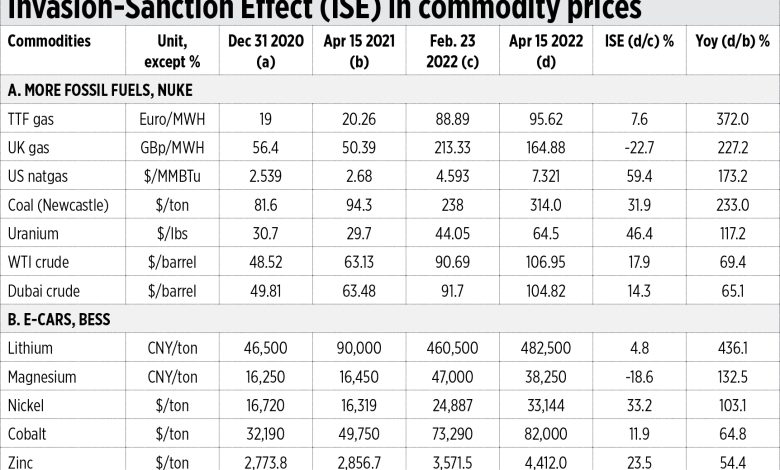Energy prices and renewables-gas lobby

There are some eyebrow-raising developments in the global and domestic energy situation captured by these recent reports in BusinessWorld:
1.) “Transition to renewables seen accelerating in response to high price of imported fuel” (March 29)
2.) “Fitch Solutions bullish on PHL power industry decarbonization” (April 7)
3.) “Think tank says hidden costs erode appeal of cheap coal power” (April 10)
4.) “ACEN to refinance unit’s loan, reinvest in renewables” (April 12)
5.) “Power rates up in April as generation charge rises” (April 12)
6.) “Battery storage seen as critical for RE adoption” (April 13).
I say “eyebrow-raising” because the expected rise in fuel and electricity prices due to the Ukraine war and stiff economic sanctions against Russia are used to further demonize fossil fuels and coal power in particular and invite blackout economics to come back in the Philippines and other countries.
For instance, report Nos. 1, 2, and 6 are about decarbonization and high imported fuel (oil, coal) — but prices of lithium, cobalt, manganese, nickel, zinc, other metals to produce solar PV, batteries for e-cars and battery energy storage system (BESS) are also high. And the price of indigenous Malampaya gas will also rise.
Report No. 3 quotes Redentor Constantino, Executive Director of the Institute for Climate and Sustainable Cities, as saying “A quick look at actual coal generation costs of major distribution utilities shows that these costs range from over P4 per kilowatt-hour to approaching P9 pesos per kWh. Not only are these costs much higher than expected but they are also volatile as they reflect ‘Pasaload’ of fuel costs to the consumer.” But Mr. Constantino is silent on the “Pasablackout” of intermittent power to the consumers when the wind does not blow and the sun is covered by thick clouds, when it rains, or it is absent at night.
Report No. 4 is about Ayala Energy’s (ACEN) 244 MW Calaca, Batangas coal plant which will be decommissioned by 2025 — 15 years ahead of end of the end of its technical life — following the Energy Transition Mechanism (ETM) of the Asian Development Bank (ADB). Ayala Energy and ADB want to further thin out already thin reserves of stable, dispatchable coal power and risk blackout economics. See this column’s piece, “ADB’s kill coal plan, government corporations, and power transmission” (Sept. 13, 2021).
And report No. 5 is expected — Meralco has to raise our electricity bill by P0.536/kwh because the cost of various components has increased: generation increased by P0.399/kwh, transmission + subsidies + system loss + taxes have increased by P0.138/kwh.
A populist and renewables lobby NGO, People for Power (P4P), led by Gerry Arances, staged a rally and issued a press release, Consumers protest Meralco greed amid new power rate hike (April 13) arguing that “coal, gas, other fossil fuels for our power supply is an electricity affordability disaster.”
Two items are wrong in the Arances “analysis”:
1.) the idea of “Meralco greed” which is disproven by the numbers in the preceding paragraph. All increases in the April electricity bill came from generation, transmission, subsidies, and taxes. There is no increase in Meralco’s distribution cost, which has been stable for nearly seven years now since July 2015.
And, 2.) “coal, fossil fuels electricity affordability disaster,” which is far out. It should be “solar-wind electricity affordability disaster” as countries that have big share of coal to total power generation like our neighbors Vietnam, Malaysia, and Indonesia have very low power prices while Europeans with a big solar-wind share to total generation like Spain, the Netherlands, Italy, the UK, and Germany have prices that are two to three times more expensive than the mentioned ASEAN countries (see Table 1). See also this column’s recent piece, “The effects of Biden and sanctions on energy and commodity prices” (March 28).
In another paper, “Profiting from outages,” Pedro Maniego cherry-picked two out of 365 days in 2021 when there was a price spike because several big coal plants extended their maintenance shutdowns, so he blames the other coal plants that continued running as profiting.
Because of this, he invites government to issue another intervention: “The regulators should investigate whether any of these dominant players who own or operate the coal plants with extended and frequent outages, benefited from the higher WESM (Wholesale Electricity Spot Market) rates.”
So, “who is profiting from the power outages” and by extension, who is profiting from thin reserves? I think the answer to both questions are the sellers of gensets, candles, and fire insurance. When there are frequent thin reserves, frequent yellow-red alerts and rotating blackouts, the rich buy gensets and the poor buy candles. More candles often lead to more fires, so there is need to buy fire insurance for one’s office and other properties.
Notice that Mr. Maniego’s paper calls for the harassment of coal plants, but not of gas plants that also experience occasional extended shutdowns and derating, or solar-wind plants that produce zero or little power when the wind does not blow and the sun is covered by thick clouds or absent at night.
And going back to the complaint of Messrs. Constantino, Arances, and Maniego that coal plants create expensive electricity — coal fuel used to be cheap, below $100/ton, but the continuing global war and underinvestment in coal mining and power plants led to tighter supply. Notice the increase in price from April 2021 to pre-invasion Feb. 23, 2022.
The gas plants in Batangas using Malampaya gas will raise their prices too because Malampaya gas prices are indexed or based on Dubai crude prices. This will start in next month’s billing as Malampaya gas prices are adjusted quarterly.
The big gas plants that are being built to use imported LNG will also charge higher prices when they start operating because LNG supply is tight, as shown in US natgas and TTF/EU gas prices.
And as mentioned above, the prices of commodities that are used to manufacture solar PV, e-car batteries, and BESS are also rising. In fact, the year-on-year (yoy) percent increase in lithium prices is six times larger than WTI and Dubai crude, four times larger than the uranium nuke price, and twice that of coal and UK gas prices (see Table 2).
The main reason why “net-zero” and decarbonize-obsessed Europe endured expensive oil-gas-coal (to avoid blackouts) even before the invasion of Ukraine is because their beloved wind-solar energy produced little power due to the less-windy, often cloudy years, 2021 and 2022.
It seems the Ukraine war will be prolonged and the sanctions against Russia and its ally trade partners will last even longer. We should expand, not shrink, our power sources. The war against coal should stop, let more coal, gas, oil, nuclear, hydro, even intermittent wind-solar plants with BESS be built. And let them compete in prices and supply stability.
I and many power consumers have “vested interests” in the energy debate: I want stable electricity, no blackouts even for a minute, no unnecessary damage to my home appliances, lights, and gadgets due to power fluctuations. I want there to be no need to buy gensets or candles. A price hike for a few days is ok as long as stable, competitive prices return for the rest of the year with no blackouts.
And please, do not ask the government for more intervention, investigation, and harassment in the competitive power generation sector. Let stiff competition be the main regulator among many private gencos. The government should instead focus its regulation and investigation on the monopoly transmission sector.
Bienvenido S. Oplas, Jr. is the president of Minimal Government Thinkers.




